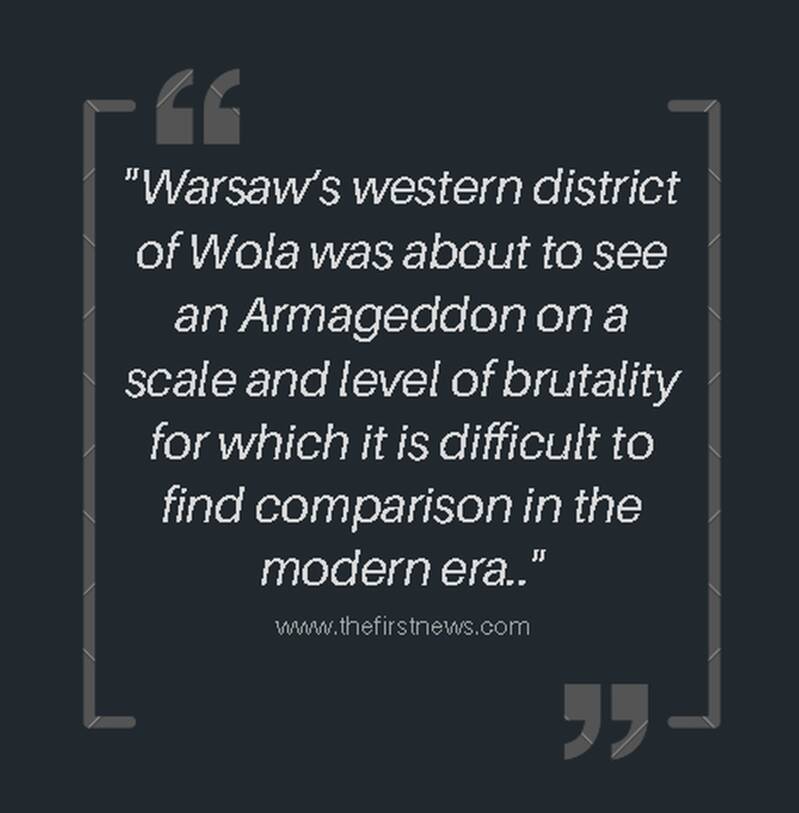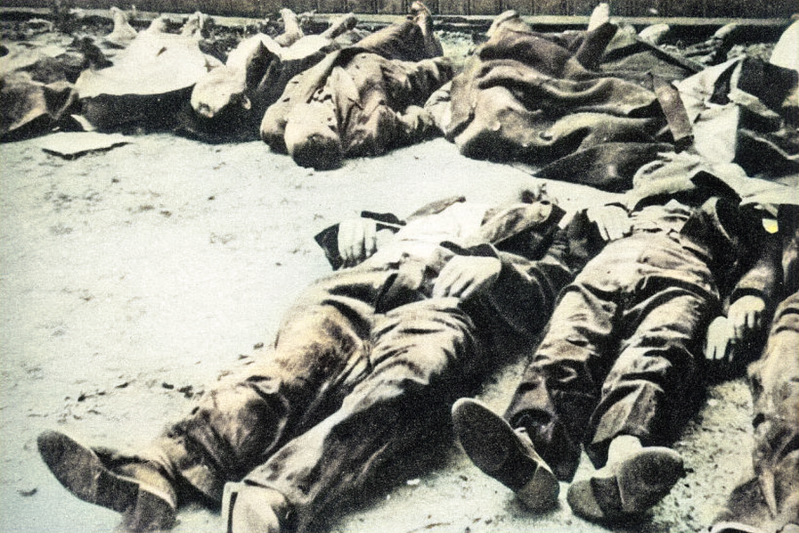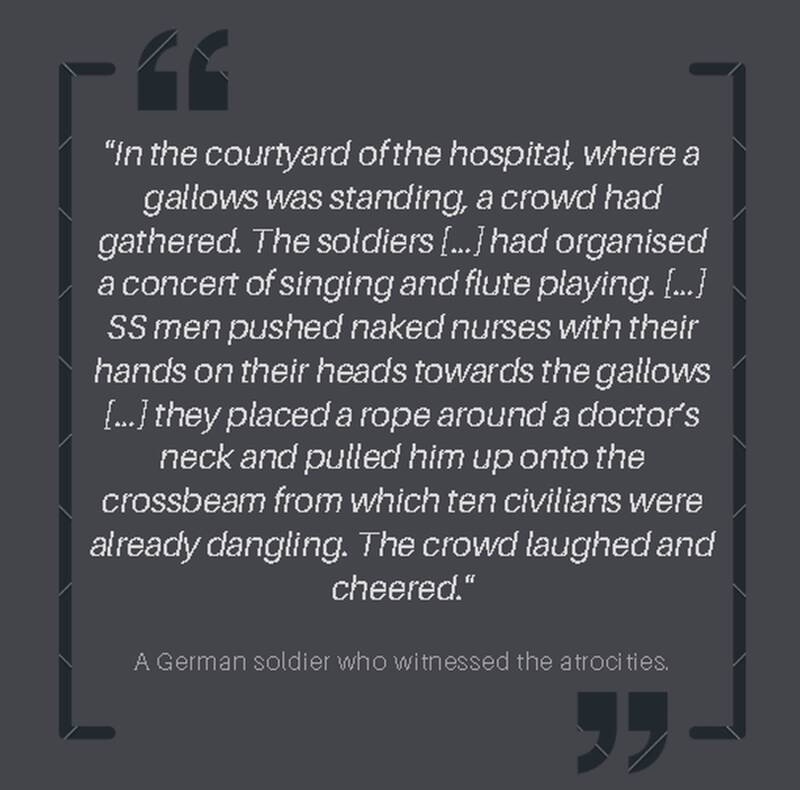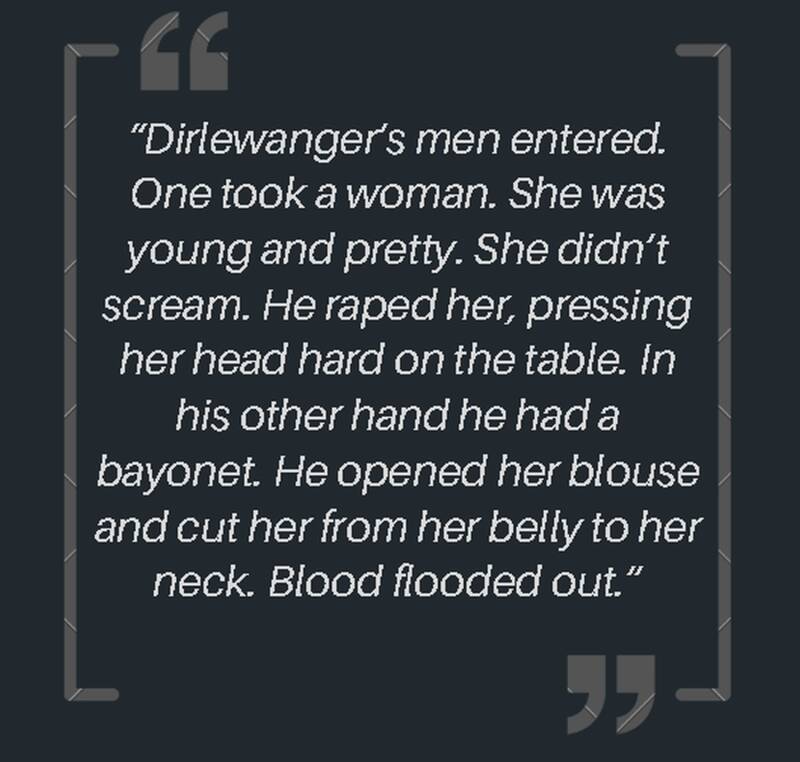A systematic slaughter
The Wola massacre was a systematic killing of between 40,000 and 50,000 Poles in Warsaw's Wola neighbourhood by the German Wehrmacht and fellow Axis collaborators in the Azerbaijani Legion, as well as mostly-Russian RONA forces, from 5 to 12 August 1944.
Adolf Hitler directed the massacre to kill "anything that moves" in order to put an end to the Warsaw Uprising soon after it began.
The Germans brutally murdered tens of thousands of Polish civilians, as well as captured Home Army resistance fighters, in planned mass executions across Wola.
Whole families, including babies, children, and the elderly, were frequently killed on the spot, but some were killed after being tortured and sexually assaulted. Soldiers murdered hospital patients, killing them in their beds as well as the doctors and nurses who cared for them.
The Verbrennungskommando ("burning detachment") piled up dead bodies to be burned in order to destroy evidence of the massacre; however, dogs were first released to find survivors to be killed.
The operation was led by Erich von dem Bach-Zelewski,(who was later critical of the excessive brutality) but the Dirlewanger Brigade and the "RONA" Kaminski Brigade were the main perpetrators.
The Germans expected that these atrocities would crush the insurrectionists' will to fight and put an end to the uprising quickly. The ruthless pacification of Wola, however backfired and only served to stiffen Polish resistance, and it took the Germans another two months of heavy fighting to retake control of the city.
Polish insurgents during the Warsaw Uprising, some using captured German equipment.
The 1944 Warsaw uprising, and its aftermath. (dispropaganda.com)
The massacre
The Warsaw Uprising began on August 1, 1944. During the first few days, the Polish resistance was able to liberate the majority of Warsaw on the left bank of the Vistula River (an uprising also broke out in the district of Praga on the right bank of the river but was quickly suppressed by the Germans).
SS General Erich von dem Bach-Zelewski was given command of all German forces in Warsaw two days after the fighting began. Following direct orders from SS-Reichsfuhrer Heinrich Himmler to crush the uprising mercilessly, his strategy included the use of terror tactics against Warsaw residents.
There would be no distinction between insurrectionists and civilians, as Himmler's orders explicitly stated that Warsaw would be completely destroyed and the civilian population would be exterminated.
Residents of Wola flee in horror as the slaughter begins.
Bundesarchiv, Bild 101I-695-0412-15 / Gutjahr / CC-BY-SA 3.0
On the 5th of August, three German battle groups advanced from the western outskirts of the Wola district, along Wolska and Górczewska streets, toward the city centre. The German forces included Wehrmacht and SS Police Battalions, as well as the mostly Russian SS-Sturmbrigade RONA and the SS-Sturmbrigade Dirlewanger, an infamous Waffen SS penal unit led by SS-Oberführer Oskar Dirlewanger, which included the Azerbaijani Legion (part of the Ostlegionen).
The two leading battle groups, Kampfgruppe "Rohr" (led by Generalmajor Günter Rohr) and Kampfgruppe "Reinefarth" (led by Heinz Reinefarth), were stopped by heavy fire from Polish resistance fighters shortly after they began their advance toward the centre of Warsaw.
The Ursus factory in Warsaw’s district Wola is set on fire by German troops. On 5th August 1944 ("Black Saturday") almost 6,000 Polish civilians were murdered there by SS killing squads.
Public domain
Unable to proceed, some German troops began to go from house to house, carrying out their orders to shoot all residents. Many civilians were killed on the spot, but others died as a result of torture and sexual assault.
Estimates vary, but Reinefarth has stated that up to 10,000 civilians were killed in the Wola district on the first day of the operation, 5th August. On the same day, two hours before midnight, Azerbaijani soldiers and the Bergmann Battalion attacked St Lazarus hospital, executed hundreds of patients, doctors, and nurses, and then burned it down.
The bodies of Polish civilians murdered by marauding Nazi German death squads in the first days of the Warsaw Uprising during the Wola Massacre.
Public domain
On the same day, the Zośka battalion of the Home Army had managed to liberate the Gęsiówka concentration camp and to take control of the strategically important surrounding area of the former Warsaw Ghetto with the aid of two captured Panther tanks belonging to a unit commanded by Wacław Micuta.
Over the next few days of fighting this area became one of the main communication links between Wola and Warsaw's Old Town district, allowing insurrectionists and civilians to gradually withdraw from Wola ahead of the superior German forces that had been deployed against them.
What followed were more acts of senseless brutality. Some German units burned down two local hospitals, leaving some patients inside.
Hundreds more patients and personnel were killed by indiscriminate gunfire and grenade attacks, or were randomly chosen and led away for executions.
It seemed the Germans – unable to capture the insurgents - were exacting a furious vengeance on the hapless civilians instead.
The railway embankment on Górczewska Street and two large factories on Wolska Street - the Ursus Factory at Wolska 55 and the Franaszka Factory at Wolska 41/45 - as well as the Pfeiffer Factory at 57/59 Okopowa Street - saw the most killings.
Thousands of people were systematically executed in mass shootings at each of these four locations, after being rounded up elsewhere and transported there in groups.
Women and children being led by German troops along Wola’s Wolska Street in early August 1944.
Bundesarchiv, Bild 101I-695-0423-14 / Leher / CC-BY-SA 3.0
Between the 8th and the 23rd August, the SS organised groups of men from the Wola district into the so-called Verbrennungskommando ("burning detachment"), which was forced to hide evidence of the massacre by burning the victims' bodies and homes.
The majority of the men forced to work in such groups were later executed.
The order to halt the indiscriminate killing of Polish civilians in Wola was issued on 12th August. Erich von dem Bach issued a new directive ordering the evacuation of captured civilians from the city and their deportation to concentration camps or Arbeitslager labour camps.
It is hard to imagine the mindset of the soldiers involved in these actions but one can only assume the sheer brutality and horror of the fighting had contributed to it – although this in no way excuses their actions.
Aftermath
No member of the German forces who took part in the atrocities committed during the Warsaw Uprising was ever prosecuted for them after the war. Heinz Reinefarth and Oskar Dirlewanger were the main perpetrators of the Wola massacre and similar massacres in the nearby Ochota district. Dirlewanger, who presided over and personally participated in many of the worst acts of violence, was apprehended by French occupation troops on 1 June 1945 while hiding under a false name near the Upper Swabia town of Altshausen.
The Monument to Victims of the Wola Massacre, displaying a list of execution sites across Wola and estimates of the number of victims at each site.
No member of the German forces who took part in the atrocities committed during the Warsaw Uprising was ever prosecuted for them after the war. Heinz Reinefarth and Oskar Dirlewanger were the main perpetrators of the Wola massacre and similar massacres in the nearby Ochota district.
Dirlewanger, who presided over and personally participated in many of the worst acts of violence, was apprehended by French occupation troops on 1st June 1945 while hiding under a false name near the Upper Swabia town of Altshausen.
Further reading
Sources:
https://en.wikipedia.org/wiki/Wola_massacre
https://www.polskieradio.pl/313
Professor Wanda Jarząbek from the Institute of Political Studies of the Polish Academy of Sciences.
Professor Timothy Snyder, of Yale University
Historian Martin Windrow
http://warsawrising.eu/?chapter=6
Bundesarchiv, Bild 183-S73495 / Anton Ahrens / CC-BY-SA 3.0
https://en.wikipedia.org/wiki/Wola_massacre#/media/File:Pomnik_ofiar_Rzezi_Woli_03.jpg
Bundesarchiv, Bild 101I-695-0412-15 / Gutjahr / CC-BY-SA 3.0
https://www.dispropaganda.com/single-post/2016/07/31/The-1944-Warsaw-uprising-and-its-aftermath
PAP/DPA
https://wiadomosci.wp.pl/zli-niemcy-zbrodniarze-fanatycy-wizjonerzy-6034076626010753g/6




















